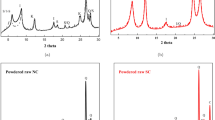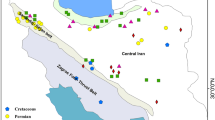Abstract
Caldeiras da Ribeira Grande fumarolic field is located in the Fogo Volcano complex, São Miguel Island (Azores Archipelago, Portugal). These are associated with a geothermal system of high enthalpy that allows the existence of singular thermal muds or peloids that are continuously mixed with water inside a manmade pool. The peloids produced by the maturation (mixture) in situ are extracted from this boiling-mud pool and used directly in a local thermal centre (the “Banhos da Coroa” centre), which exists since 1811, for the relief of pain associated with rheumatic diseases and skin disorders treatment. Until this investigation, the application of sediments from Ribeira Grande for pelotherapy ends was only evaluated by human perception. Thus, this work aims the physical, mineralogical and geochemical characterization of the peloids collected inside the boiling-mud pool and the evaluation of their potential to be used for aesthetic and therapeutic purposes. The assessment of the volume of clays available for exploitation is also estimated. Sediments from Caldeiras da Ribeira Grande are naturally heated (above 36 °C in most of the cases) and present pH up to 5. The X-ray fluorescence analyses revealed a high content on Si and S, which are useful for therapeutic purposes and the risk inherent to potential toxic elements’ concentrations was evaluated. The X-ray diffraction data showed the presence of clay minerals, sulphates (alunite) and feldspars. Additionally to these features, silty-clay fraction also exhibits interesting features, such as suitable abrasivity and high plasticity. A detailed field survey was carried out at the Caldeiras da Ribeira Grande boiling-mud pool, including the measurement of the sediments thickness at 45 points and the determination of the ratio wet to dry sediments weight. This allowed to estimate a volume of sediments available for exploitation of 84 m3, or about 36 ton of dry sediments.






Similar content being viewed by others
References
Baschini M, Pettinari G, Vallés J, Aguzzi C, Cerezo P, López-Galindo A, Setti M, Viseras C (2010) Suitability of natural sulphur-rich muds from Copahue (Argentina) for use as semisolid health care products. Appl Clay Sci 49(3):205–212. doi:10.1016/j.clay.2010.05.008
Bender T, Karagülle Z, Bálint G, Gutenbrunner C, Bálint P, Sukenik S (2005) Hydrotherapy, balneotherapy, and spa treatment in pain management. Rheumatol Int 25:220–224
Bowe W, Shalita A (2008) Effective over-the-counter acne treatments. Semin Cutan Med Surg 27(3):170–176
Brindley G, Brown G (1980) Crystal structures of clay minerals and their X-ray identification. Mineralogical Society, Monograph no.5, London
Britschka Z, Teodoro W, Velosa A, Mello S (2007) The efficacy of Brazilian black mud treatment in chronic experimental arthritis. Rheumatol Int 28:39–45
Carretero M, Pozo M (2009) Clay and non-clay minerals in the pharmaceutical industry: part I. Excipients and medical applications. Appl Clay Sci 46(1):73–80. doi:10.1016/j.clay.2009.07.017
Carretero M, Pozo M (2010) Clay and non-clay minerals in the pharmaceutical and cosmetic industries Part II. Active ingredients. Appl Clay Sci 47(3–4):171–181. doi:10.1016/j.clay.2009.10.016
Carvalho M (1999) Hidrogeologia do Maciço Vulcânico de Água de Pau/Fogo (São Miguel Açores). Dissertação Doutoramento, Universidade de Lisboa
Carvalho M, Forjaz VH, Almeida C (2006) Chemical composition of deep hydrothermal fluids in the Ribeira Grande geothermal field (São Miguel, Azores). J Volcanol Geotherm Res 156(1–2):116–134. doi:10.1016/j.jvolgeores.2006.03.015
Carvalho M, Mateus A, Nunes J, Carvalho J, Capaso G, Grassa F, Sá H (2013) Influência do grau de ebulição do fluido na formação de peloides nos polos fumarólicos do Vulcão do Fogo (S. Miguel, Açores). In: Nunes JC, Silva JB, Gomes CF, INOVA (eds) Proceedings “3rd Iberoamerican Congress of Peloids”, INOVA, Azores, pp 247–253
Chilvers D, Peterson P (1987) Global cycling of arsenic. In: Hutchinson TC, Meema KM (eds) Lead, mercury, cadmium and arsenic in the environment SCOPE, vol 31. Wiley, New York, pp 279–301
Cruz J (2003) Groundwater and volcanoes: examples from the Azores Archipelago. Environ Geol 44:343–355
Cruz J, Freire P, Costa A (2010) Mineral waters characterization in the Azores archipelago (Portugal). J Volcanol Geotherm Res 190(3–4):353–364. doi:10.1016/j.jvolgeores.2009.12.001
European Medicines Agency (2008) Guideline on the specification limits for residual metal catalysts for metal reagents. http://www.ema.europa.eu/docs/en_GB/document_library/Scientific_guideline/2009/09/WC500003586.pdf. Accessed July 2014
Evcik D, Kavuncu V, Yeter A, Yigit I (2007) The efficacy of balneotherapy and mud pack therapy in patients with knee osteoarthritis. Joint Bone Spine 74:60–65
Ferrand T, Yvon J (1991) Thermal properties of clay pastes for pelotherapy. Appl Clay Sci 16:21–38
Fioravanti A, Cantarini L, Guidelli GM, Galeazzi M (2011) Mechanisms of action of spa therapies in rheumatic diseases: what scientific evidence is there? Rheumatol Int 31:1–8
Galhano C, Rocha F, Gomes C (1999) Geostatistical analysis of the influence of textural, mineralogical and geochemical parameters on the geotechnical behaviour of the “Argilas de Aveiro” formation (Portugal). Clay Min 34:109–116
Galzigna L, Ceschi-Berrini C, Moschin E, Tolomeo C (1998) Thermal mud-pack as anti-inflammatory treatment. Biomed Pharmacother 52:408–409
Health Canada (2012) Guidance on heavy metal impurities in cosmetics. http://www.hc-sc.gc.ca/cps-spc/pubs/indust/heavy_metals-metaux_lourds/index-eng.php. Accessed July 2014
Holtz RD, Kovacs WD (1981) An introduction to geotechnical engineering. Prentice-Hall, Englewood Cliffs
Kazandjieva J, Grozdev I, Darlenski R, Tsankov N (2008) Climatotherapy of psoriasis. Clin Dermatol 26:477–485
Khlaifat A, Al-Khashman O, Qutob H (2010) Physical and chemical characterization of Dead Sea mud. Mater Charact 61(5):564–568
Klee S, Farwick M, Lersch P (2009) Triggered release of sensitive active ingredients upon response to the skin’s natural pH. Colloids Surf A Physicochem Eng Asp 338:162–166
Klinkenberg M, Rickertsen N, Kaufhold S, Dohrmann R, Siegesmund S (2009) Abrasivity by bentonite dispersions. Appl Clay Sci 46:37–42
Lange U, Müller-Ladner U, Schmidt K (2006) Balneotherapy in rheumatic diseases-an overview of novel and known aspects. Rheumatol Int 26:497–499
Mellinger RM (1979) Quantitative X-ray diffraction analysis of clay minerals. An evaluation. Saskatchenwan Res. Council, Canada, SRC Report G-79:1–46
Momani K, El-Hasan T, Auaydeh S, Al-Nawayseh K (2009) Heavy metals distribution in the Dead Sea black mud, Jordan. Jordan J Earth Environ Sci 2(2):81–88
Nasermoaddeli A, Kagamimori S (2005) Balneotherapy in medicine: a review. Environ Health Prev Med 10:171–179
Neubold H, Sennett P, Morris H (1982) Abrasiveness of pigments and extenders. Tech Assoc Pulp Pap Ind J 65:90–93
Oliveira A, Rocha F, Rodrigues A, Jouanneau J, Dias A, Weber O, Gomes C (2002) Clay minerals from the sedimentary cover from the Northwest Iberian shelf. Prog Oceanogr 52:233–247
Parcell S (2002) Sulfur in human nutrition and applications in medicine. Altern Med Rev 7(1):22–44
Poensin D, Carpentier P, Féchoz C, Gasparini S (2003) Effects of mud pack treatment on skin microcirculation. Joint Bone Spine 7:367–370
Quintela A, Terroso D, Costa C, Almeida SFP, Sá H, Nunes J, Rocha F (2013) Composição mineralógica e diatomológica dos sedimentos argilosos existentes no tanque das Caldeiras da Ribeira Grande: evidências de maturação in situ. In: Proceedings of the 3rd Iberoamerican Congress of peloids pp 76–85
Quintela A, Terroso D, Ferreira da Silva E, Rocha F (2012) Certification and quality criteria of peloids in use for therapeutic purposes. Clay Min 47(4):441–451. doi:10.1180/claymin.2012.047.4.04
Vallés J, Baschini M, Pettinari G, García N (2004) Characterization of muds and waters of the Copahue geothermal field, Neuquen Province, Patagonia Argentina. In: Proceedings of the 8th International Congress on Applied Mineralogy pp 507–510
Veniale F, Barberis E, Carcangiu G, Morandi N, Setti M, Tamanini M, Tessier D (2004) Formulation of muds for pelotherapy: effects of “maturation” by different mineral waters. Appl Clay Sci 25:135–148
Veniale F, Bettero A, Jobstraibizer P, Setti M (2007) Thermal muds: perspectives of innovations. Appl Clay Sci 36:141–147
Wallestein N, Duncan A, Chester D, Marques R (2007) Fogo Volcano (São Miguel, Azores): a hazardous edifice. Géomorphol Relief Process Environ 3:259–270
Acknowledgments
This research was supported by the TERMAZ Project, promoted by the INOVA Institute and financed by the PROCONVERGÊNCIA UE Programme and the Azores Government, and the Project PEst-C/CTE/UI4035/2011.
Author information
Authors and Affiliations
Corresponding author
Rights and permissions
About this article
Cite this article
Quintela, A., Terroso, D., Costa, C. et al. Characterization and evaluation of hydrothermally influenced clayey sediments from Caldeiras da Ribeira Grande fumarolic field (Azores Archipelago, Portugal) used for aesthetic and pelotherapy purposes. Environ Earth Sci 73, 2833–2842 (2015). https://doi.org/10.1007/s12665-014-3438-8
Received:
Accepted:
Published:
Issue Date:
DOI: https://doi.org/10.1007/s12665-014-3438-8




